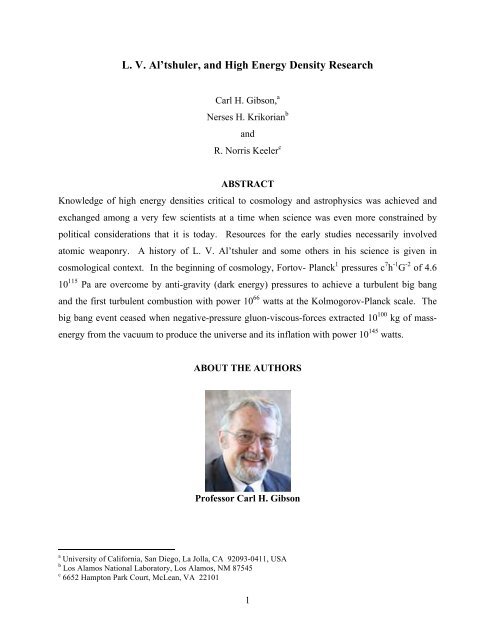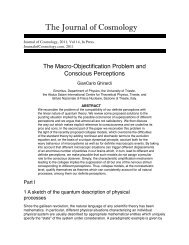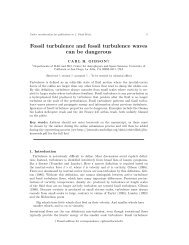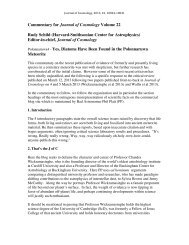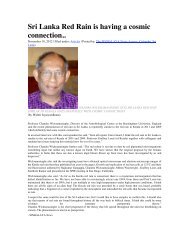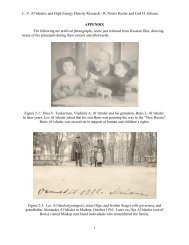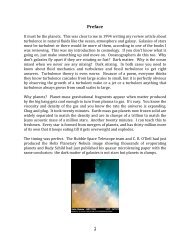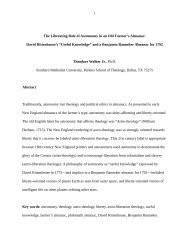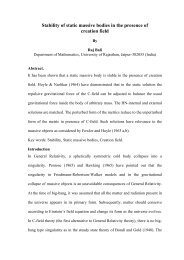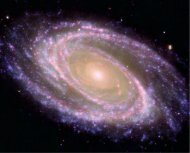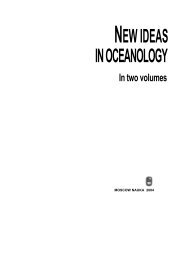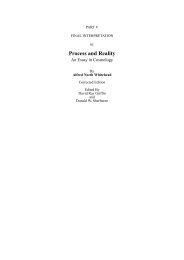L. V. Al'tshuler, and High Energy Density Research - Journal of ...
L. V. Al'tshuler, and High Energy Density Research - Journal of ...
L. V. Al'tshuler, and High Energy Density Research - Journal of ...
You also want an ePaper? Increase the reach of your titles
YUMPU automatically turns print PDFs into web optimized ePapers that Google loves.
L. V. Al’tshuler, <strong>and</strong> <strong>High</strong> <strong>Energy</strong> <strong>Density</strong> <strong>Research</strong><br />
Carl H. Gibson, a<br />
Nerses H. Krikorian b<br />
<strong>and</strong><br />
R. Norris Keeler c<br />
ABSTRACT<br />
Knowledge <strong>of</strong> high energy densities critical to cosmology <strong>and</strong> astrophysics was achieved <strong>and</strong><br />
exchanged among a very few scientists at a time when science was even more constrained by<br />
political considerations that it is today. Resources for the early studies necessarily involved<br />
atomic weaponry. A history <strong>of</strong> L. V. Al’tshuler <strong>and</strong> some others in his science is given in<br />
cosmological context. In the beginning <strong>of</strong> cosmology, Fortov- Planck 1 pressures c 7 h -1 G -2 <strong>of</strong> 4.6<br />
10 115 Pa are overcome by anti-gravity (dark energy) pressures to achieve a turbulent big bang<br />
<strong>and</strong> the first turbulent combustion with power 10 66 watts at the Kolmogorov-Planck scale. The<br />
big bang event ceased when negative-pressure gluon-viscous-forces extracted 10 100 kg <strong>of</strong> massenergy<br />
from the vacuum to produce the universe <strong>and</strong> its inflation with power 10 145 watts.<br />
ABOUT THE AUTHORS<br />
Pr<strong>of</strong>essor Carl H. Gibson<br />
a University <strong>of</strong> California, San Diego, La Jolla, CA 92093-0411, USA<br />
b Los Alamos National Laboratory, Los Alamos, NM 87545<br />
c 6652 Hampton Park Court, McLean, VA 22101<br />
1
Gibson is the Founding Editor in Chief <strong>of</strong> the <strong>Journal</strong> <strong>of</strong> Cosmology <strong>and</strong> Pr<strong>of</strong>essor <strong>of</strong><br />
Engineering Physics <strong>and</strong> Oceanography in the Departments <strong>of</strong> Mechanical <strong>and</strong> Aerospace<br />
Engineering at the University <strong>of</strong> California, San Diego. He is a Fellow <strong>of</strong> the American Physical<br />
Society, an Academician <strong>of</strong> the International Eurasian Academy <strong>of</strong> Sciences, <strong>and</strong> one <strong>of</strong> their<br />
Gold Medal recipients.<br />
Pr<strong>of</strong>essor Gibson’s interest in Lev Al’tshuler derives from Al’tshuler’s role in creating a new<br />
field; that is, experimental cosmology or experimental astrophysics. This discipline consists <strong>of</strong><br />
carrying out laboratory measurements under conditions occurring in the Cosmos. Following<br />
Al’tshuler <strong>and</strong> Zel’dovich, <strong>and</strong> most recently by V. E. Fortov, these experiments have given us<br />
data on which we may base many <strong>of</strong> our cosmological theories. The work <strong>of</strong> Fortov, a student <strong>of</strong><br />
Zel’dovich, will be discussed later. 2 Ya. B. Zel’dovich, a co-worker <strong>of</strong> Al’tshuler (who was a<br />
mentor <strong>and</strong> colleague <strong>of</strong> Fortov), left the field in 1966, shifted to cosmology, <strong>and</strong> worked out a<br />
number <strong>of</strong> concepts with Academician Sunyaev.<br />
Gibson 3 identified the dark matter <strong>of</strong> galaxies as earth-mass primordial gas planets in millionsolar-mass<br />
clumps (proto-globular-star-clusters). Schild, 4 the present Editor-in-Chief <strong>of</strong> the<br />
<strong>Journal</strong> <strong>of</strong> Cosmology, provided a completely independent confirmation <strong>of</strong> this prediction based<br />
on fifteen years <strong>of</strong> careful observations <strong>of</strong> quasar microlensing by a galaxy, where he concluded<br />
the missing mass <strong>of</strong> the lensing galaxy was not stars but planets. Together Gibson/Schild have<br />
developed hydrogravitational dynamics cosmology, where all stars form from mergers <strong>of</strong> frozen<br />
HHe 4 planets within trillion-planet clumps. HGD cosmology combined with<br />
Wickramasinghe/Hoyle cometary panspermia provides a physical basis for a biological big bang<br />
in time interval 2-8 Myr after the cosmological big bang when the first stars produced the first<br />
chemicals <strong>and</strong> the first planet oceans. 5 Pr<strong>of</strong>essor Wickramasinghe is the third scientific editor <strong>of</strong><br />
the <strong>Journal</strong> <strong>of</strong> Cosmology. He <strong>and</strong> Hoyle founded the Cardiff University Center for<br />
Astrobiology (now at Buckingham University) thirty years ago, <strong>and</strong> have pioneered the field <strong>of</strong><br />
Astrobiology. The Founding Managing Editor <strong>of</strong> the <strong>Journal</strong> <strong>of</strong> Cosmology Dr. Rhawn Joseph<br />
has demonstrated the critical importance <strong>of</strong> horizontal gene transfer to evolution. 6<br />
2
Dr. Nerses H. Krikorian<br />
Dr. Nerses H. Krikorian was a part <strong>of</strong> the original Manhattan Project in 1943 at Union Carbide in<br />
Niagara Falls, where he produced high purity uranium. He transferred to Los Alamos in 1946<br />
where as a chemist he became involved, over the years, in all aspects <strong>of</strong> chemistry that were part<br />
<strong>of</strong> the Laboratory’s programs.<br />
Specifically, these were radiochemistry, inorganic <strong>and</strong> physical chemistry, high temperature<br />
chemistry <strong>and</strong> material science.<br />
Krikorian soon became a source <strong>of</strong> insights on what Russia, China <strong>and</strong> others were capable <strong>of</strong><br />
doing in the nuclear field. He soon became an important part <strong>of</strong> bi- <strong>and</strong> multilateral meetings on<br />
such topics. For his work he was honored in 1991 with the Intelligence Community Medallion,<br />
presented by the CIA Director. He was one <strong>of</strong> the very first Americans to visit Sarova in 1991,<br />
<strong>and</strong> later, Chelyabinsk 90.<br />
In 2003, he was awarded the Los Alamos Medal, the highest honor that can be bestowed on a<br />
Los Alamos employee.<br />
Krikorian is fluent in Russian <strong>and</strong> Armenian, <strong>and</strong> is a member <strong>of</strong> the Armenian Academy <strong>of</strong><br />
Sciences.<br />
3
Dr. R. Norris Keeler<br />
Dr. R. Norris Keeler worked in the field <strong>of</strong> high dynamic pressures for two decades. He was the<br />
first US physicist to be elected as a Fellow <strong>of</strong> the American Physical Society based on his work<br />
in the high dynamic pressure field. He served as two term President <strong>of</strong> the International <strong>High</strong><br />
Pressure Society, AIRAPT. Keeler was only the second Westerner to actually meet with Lev<br />
Al’tshuler. His initial association with the Russian Scientific community led to his initiating<br />
several joint programs with Russian scientists. He was recently announced as the 2010 winner <strong>of</strong><br />
the N. N. Semenov gold medal <strong>of</strong> the Russian Academy <strong>of</strong> Sciences for outst<strong>and</strong>ing<br />
accomplishments in <strong>Research</strong> <strong>and</strong> Development. On February 19, 2009, he gave an address to<br />
the Houston Philosophical Society on the accomplishments <strong>of</strong> Lev Al’tshuler.<br />
L. V. AL’TSHULER AND HIGH ENERGY DENSITY RESEARCH<br />
In writing about Lev Al’tshuler it is important to appreciate that most <strong>of</strong> the hitherto unknown or<br />
previously classified aspects <strong>of</strong> Al’tshuler’s life are available to the scientists <strong>and</strong> associates who<br />
helped the first author prepare this paper. Al’tshuler developed experimental techniques used<br />
then <strong>and</strong> later to obtain data for high pressure geophysics, planetary physics <strong>and</strong> astrophysics.<br />
This work was principally carried out by V. E. Fortov <strong>and</strong> his group in Russia, <strong>and</strong> a recent<br />
summary <strong>of</strong> this work will be available in this journal. 2 Fortov has recently published a text<br />
“Experiments under Extreme Conditions”, which is available in Russian, but will shortly be<br />
printed in English.<br />
In the pursuit <strong>of</strong> nuclear weapon capability both the US <strong>and</strong> Russia required high pressure<br />
dynamic equation <strong>of</strong> state (EOS) measurements to underst<strong>and</strong> the response <strong>of</strong> nuclear materials<br />
4
to high dynamic pressure loading. The Manhattan Project scientists who were well acquainted<br />
with shock wave effects were Hans Bethe <strong>and</strong> Edward Teller. In 1940 Theodore von Karman <strong>of</strong><br />
the California Institute <strong>of</strong> Technology encouraged them both to become involved in armor<br />
penetration physics. Bethe published on this topic. 7 This discipline, <strong>of</strong>ten called “shock wave<br />
physics” became part <strong>of</strong> the Manhattan Project under the direction <strong>of</strong> Roy Goranson, a high<br />
pressure geophysicist at the Carnegie Institution, as none <strong>of</strong> the project’s principals were<br />
specialists in the discipline. Goranson, in fact, was a static high pressure geophysicist, but<br />
clearly understood the role dynamic pressure could play in compression <strong>of</strong> fissile material to<br />
criticality. He was not one <strong>of</strong> the close inner circle around Oppenheimer, however. The first US<br />
A-bomb, a uranium based gun arrangement, was designed by Francis Birch. Seth Neddermeyer<br />
insisted on an implosion based system using plutonium, which after Taylor instability problems<br />
were solved, because the basic design for all future fission devices.<br />
During the Second World War <strong>and</strong> afterwards, the existence <strong>of</strong> the Soviet Nuclear Weapons<br />
Program provided a small nucleus <strong>of</strong> scientists free from party interference with their activities,<br />
<strong>and</strong> these scientists, recipients <strong>of</strong> numerous awards, both national <strong>and</strong> international, up to an<br />
including several Nobel Prizes, are well known in the Western scientific <strong>and</strong> political literature.<br />
This situation is well described by Holloway, 8 among other historians. 9<br />
Lev Al’tshuler (9/11/1913-23/12/2003) who was as scientifically accomplished as any <strong>of</strong> the<br />
others, has not been as broadly recognized. This is for a number <strong>of</strong> reasons. He was not widely<br />
traveled, did not speak English, <strong>and</strong> was rather shy <strong>and</strong> retiring outside his Russian scientific<br />
circles. He was a man <strong>of</strong> the highest scientific integrity <strong>and</strong> this led to conflicts with party<br />
bureaucrats, <strong>and</strong> he had no compunctions about aggressively defending his beliefs. In the course<br />
<strong>of</strong> his programmatic activities, he also became the father, as it were, <strong>of</strong> an entire area <strong>of</strong> physics;<br />
the use <strong>of</strong> high dynamic pressure to study the properties <strong>of</strong> materials under extreme conditions.<br />
Lev Vladimirovich Al’tshuler was born in Moscow on 9 November 1913, the son <strong>of</strong> Anna Esfir’<br />
Kershner-Al’tshuler (1881-1968) <strong>and</strong> Vladimir Al’tshuler (1882-1965), a lawyer who was one <strong>of</strong><br />
the active leaders <strong>of</strong> the Russian revolution. (Both are shown in Figure 1-1.) The senior<br />
Al’tshuler held a number <strong>of</strong> high posts under Stalin, but fortunately avoided being a victim <strong>of</strong> the<br />
5
many purges taking place during that period. Mrs. Al’tshuler was a homemaker, raising three<br />
children <strong>and</strong> being a center <strong>of</strong> a “spiritual gravitational anomaly” as described by her children,<br />
with intellectual pursuits for an entire extended family. Al’tshuler had a brother, Sergei (1909-<br />
1979), who was a science historian <strong>and</strong> a sister Olga (1912-1992), a chemist. In the early years,<br />
Vladimir Al’tshuler did a number <strong>of</strong> tasks in support <strong>of</strong> the revolution. At one point in time, he<br />
was given the assignment <strong>of</strong> delivering a certain sum <strong>of</strong> money to V. I. Lenin, at that time<br />
residing in Zurich. Upon arriving in Zurich, the elder Al’tshuler deposited the funds at a storage<br />
facility at the Zurich railway station, <strong>and</strong> set out to find Lenin. Upon finding him, Al’tshuler<br />
suggested that he might join him for a cup <strong>of</strong> tea. Lenin immediately dem<strong>and</strong>ed that Al’tshuler<br />
return to the station <strong>and</strong> recover the money <strong>and</strong> bring it to him. “Then, we can talk about a cup<br />
<strong>of</strong> tea”.<br />
Figure 1-1: L. V. Al’tshuler’s Parents: V. A. Al’tshuler <strong>and</strong> Anna L. Kershner-Al’tshuler,<br />
Moscow, 1945<br />
Lev Al’tshuler was home schooled from age 7-10, <strong>and</strong> from 10-17 attended state schools. It was<br />
here he first met Veniamin Tsukerman, who was to play such an important role in Al’tshuler’s<br />
life. Tsukerman recalls, “When we were in school, I first saw Lev Al’tshuler engaged in a<br />
heated argument with another student. No sooner had I turned away when an inkwell shattered<br />
against the wall.” I thought to myself, “I like the quickness <strong>of</strong> reaction. This one is always able<br />
to st<strong>and</strong> up for himself. Now, our friendship can begin.”<br />
6
Al’tshuler graduated with a diploma <strong>of</strong> “Foreman in Construction.” He was ordered to a<br />
collective farm in the Volga River Region, with orders to construct pig sties. This effort was a<br />
failure because as Al’tshuler reminisced later, “I couldn’t set the fence posts straight.”<br />
Discouraged, in 1932, he returned to Moscow to look up his friend Tsukerman. Tsukerman<br />
invited him to work in the Roentgen laboratory <strong>of</strong> the “Evening Machine-Building Institute.”<br />
(This laboratory was eventually moved to the Soviet Academy <strong>of</strong> Sciences in 1939.) Tsukerman<br />
had also been able to bring Vitaly Ginzberg into the laboratory in 1931 as a 15 year old boy with<br />
no prospects. So, Tsukerman brought both Al’tshuler <strong>and</strong> Ginzberg into his laboratory when<br />
neither had viable prospects for further education – not to speak <strong>of</strong> meaningful employment.<br />
Thus began a friendship between these three men, which lasted for half a century.<br />
Al’tshuler’s first science teacher at the laboratory was Evgeniy Bakhmetiev, the lab director who<br />
was seized <strong>and</strong> imprisoned in 1935, <strong>and</strong> perished as a victim <strong>of</strong> Stalin’s purges. He had<br />
originally hired Veniamin Tsukerman as a young engineer to his laboratory in 1930. He exerted<br />
a strong influence on Al’tshuler in his earliest years. As mentioned previously, at this laboratory,<br />
Al’tshuler first met Vitaly Ginzberg, the future Nobel Laureate when both were hired together.<br />
Al’tshuler entered Moscow State in advanced placement as a junior in 1934 <strong>and</strong> he graduated in<br />
1936 as a physical metallurgist in the x-ray analysis section <strong>of</strong> the Physics Department. He<br />
remained at what had become Tsukerman’s laboratory after the loss <strong>of</strong> Bakhmetiev in 1935. The<br />
lab was moved to the Academy <strong>of</strong> Sciences’ Institute <strong>of</strong> Engineering in 1939. The laboratory<br />
was then assigned the task <strong>of</strong> using flash x-ray sources to image bullets <strong>and</strong> other rapid moving<br />
objects. At this time Ginzberg moved over to the Lebedev Institute.<br />
After the German attack on Russia on 22 June 1941, Al’tshuler was mobilized <strong>and</strong> was assigned<br />
to the Air Force branch <strong>of</strong> the Red Army as a senior mechanic-lieutenant in the bomber force. In<br />
1942, at the request <strong>of</strong> the Academy <strong>of</strong> Sciences, 1,000 scientists were recalled from the front<br />
<strong>and</strong> evacuated to Kazan’ <strong>and</strong> Al’tshuler was one <strong>of</strong> the 1,000, <strong>and</strong> was assigned to the Academy<br />
<strong>of</strong> Sciences Laboratory headed by his friend Tsukerman. (Al’tshuler, wife, <strong>and</strong> son are show in<br />
Kazan’ in Figure 1-2.) In this facility he first met Yakov Zel’dovich <strong>and</strong> Yuli Khariton.<br />
7
Figure 1-2: Senior Mechanic Lieutenant Lev Al’tshuler, his wife Maria Speranskaya <strong>and</strong> son<br />
Boris in 1942, after evacuation to Kazan’<br />
Conditions were drastic at Kazan’ initially. Veniamin Tsukerman provided some <strong>of</strong> his own<br />
lodging for Al’tshuler’s sister Olga <strong>and</strong> her family, several <strong>of</strong> whom were in poor health. He<br />
also made sure that Al’tshuler had the very best co-workers. Initially, these were K. K.<br />
Krupnikov <strong>and</strong> S. B. Kormer.<br />
The laboratory had responsibility for addressing various issues applying to the ongoing conflict.<br />
The first problem Al’tshuler was assigned was to investigate why German antitank projectiles<br />
were so effective against Russian tank armor. He <strong>and</strong> Tsukerman did flash x-ray radiography <strong>of</strong><br />
artillery shells <strong>and</strong> found that the German shells used multiple jet effects to achieve maximum<br />
damage. For this accomplishment, the two researchers received their first State Award, <strong>and</strong> a<br />
personal commendation from Igor Kurchatov. Eventually, in 1946, Khariton invited them both<br />
to join the Soviet atomic project at Sarov, just getting organized.<br />
Ginzberg, however, was not asked to join the Sarov project until 1948, being considered<br />
politically suspect. He had been forced to remain in isolation because his wife, Nina Ermakova<br />
was repressed in 1944 <strong>and</strong> charged with anti-Soviet activity. Ginzberg married her in 1946,<br />
when she was in exile in Gorky. She had been charged with planning to assassinate Stalin, but<br />
when the KGB found her window opened to an interior courtyard the charges were reduced. But<br />
she was still sentenced to internal exile after three years in prison – a sentence reduced to nine<br />
8
months. All charges <strong>and</strong> penalties were dropped after the death <strong>of</strong> Stalin in 1953. Nevertheless,<br />
Ginzberg was asked to join Andrei Sakharov as part <strong>of</strong> Igor Tamm’s group at the Lebedev<br />
Institute, which supported Khariton’s project at Sarov.<br />
In the spring <strong>of</strong> 1947, Al’tshuler moved to Sarov, north <strong>of</strong> Moscow to join the Soviet Atomic<br />
Project. This city was associated with the retreat <strong>of</strong> an 18 th century Russian holy man, Saint<br />
Seraphim Sarovsky. He brought his family with him – his wife, Maria Speranskaya (1916-1977)<br />
<strong>and</strong> two sons, Boris (b. 1939) <strong>and</strong> Alex<strong>and</strong>er (b. 1945). A third son, Michael, was born at Sarov<br />
in 1955.<br />
In 1946, Igor Kurchatov had been placed in charge <strong>of</strong> the Russian Atomic Project, under the<br />
surveillance <strong>of</strong> Lavrenty Beria, head <strong>of</strong> the KGB. At the Sarov site, the leaders were Yuli<br />
Borisovich Khariton, Yakov Zel’dovich, later on, Andrei Sakharov, Igor Tamm (who remained<br />
at the Lebedev Institute in Moscow), <strong>and</strong> others. In the beginning, Zel’dovich organized the<br />
theoretical effort <strong>and</strong> Tsukerman organized the experimental effort. Of course the goal <strong>of</strong> the<br />
effort was to see how much energy from high explosives detonation was required to compress<br />
fissile material to the critical mass required to achieve nuclear fission. Soon US data <strong>and</strong> details<br />
were made available through espionage. This type <strong>of</strong> information was held very tightly; for<br />
example, it was not available to Al’tshuler or Sakharov, but was available at first to Kurcharov<br />
<strong>and</strong> Khariton, <strong>and</strong> later on, to Zel’dovich.<br />
With the organization just beginning to be formed, it was decided that the Russian program<br />
should be based on duplicating the American results. Since the information on the US A-bomb<br />
was considered intelligence, the only scientists aware <strong>of</strong> this decision were Kurchatov <strong>and</strong><br />
Khariton. This created certain problems. Al’tshuler argued that a design he could do would be<br />
far superior. However, since failure was not an option, it was necessary to go with the<br />
successfully tested (by the US) design. However, the Russian team was not allowed to accept<br />
these intelligence retrievals at face value (although they did not know the origin <strong>of</strong> the material)<br />
– they were required to check them very thoroughly. This procedure was puzzling to Al’tshuler<br />
<strong>and</strong> others, until they understood the reason for it many years later.<br />
9
In addition to his overall responsibilities cited previously, Tsukerman took charge <strong>of</strong> an<br />
experimental division whose function was to carry out “hydro” shots (nomenclature used by<br />
Western weapons researchers), using pulsed x-ray techniques developed with Al’tshuler<br />
previously. His collaborators were Arkady A. Brish, Vera S<strong>of</strong>ina, Diador Tarasov <strong>and</strong> Marya<br />
Manakova. Other techniques used were explosive flash driven photography directed by Ilya Sh.<br />
Model’, <strong>and</strong> electrical contact shock wave diagnostics by K. K. Krupnikov. This work continued<br />
later under N. G. Makeev <strong>and</strong> Y. M. Makarov.<br />
Evgeniy K. Zavoiski ran a division using electromagnetic methods for measuring the velocity <strong>of</strong><br />
explosion products <strong>and</strong> from this to derive the detonation pressure inside the charge. This<br />
technique was used extensively at the ICP at Chernogolovka in later years, where high explosive<br />
research was carried out, much <strong>of</strong> it supporting the activity at Sarov.<br />
Al’tshuler had responsibility for equations <strong>of</strong> state. Here he worked with spherical implosion<br />
systems about 20 cm in diameter, immediately producing multimegabar pressures. All<br />
development <strong>of</strong> equation <strong>of</strong> state techniques was carried out under Al’tshuler’s direction. His<br />
group included his personal colleagues from Kazan’; including Samuil B. Kormer, who with<br />
Zel’dovich mastered the measurement <strong>of</strong> temperature behind shock waves. His other Kazan’ coworker<br />
K. K. Krupnikov was joined by Boris Ledyenov, Anna A. Bakanova, M. N. Pavlovskiy,<br />
R. F. Trunin, <strong>and</strong> A. I. Funtikov.<br />
Kiril I. Shchelkin directed the division <strong>of</strong> full-scale field test prototypes, assisted by his deputy<br />
Viktor I. Zhuchikhin. Shchelkin himself was the discoverer <strong>of</strong> “Spinning Detonation,” striking<br />
evidence <strong>of</strong> detonation instability in gas phase detonations. (The same effect in solids was<br />
observed at Livermore by A. Kusubov <strong>of</strong> the USA in 1967.) The prototypes were exact copies,<br />
1.5 to 2.0 meters in diameter, <strong>of</strong> the fission device designs, but U238 (ρ=19 g/cc) was substituted<br />
for U235/Pu 239. For alpha phase plutonium, a U238 alloy <strong>of</strong> the appropriate (reduced) density<br />
was fabricated at the Solid Alloy Plant in Moscow <strong>and</strong> used in the prototypes.<br />
Following the direction <strong>of</strong> Yuli Khariton, the Soviet replica <strong>of</strong> Fat Man was constructed, fielded<br />
<strong>and</strong> tested successfully on August 29, 1949. After this successful test, Khariton promised<br />
10
Al’tshuler that after his team carefully analyzed the data from this test, he would be able to<br />
design the second test device. This device using his design was fielded <strong>and</strong> tested on September<br />
25, 1951. This device, “Joe 2,” was half the size <strong>and</strong> weight <strong>of</strong> the initial test, called in the West<br />
“Joe 1,” <strong>and</strong> had twice the yield <strong>of</strong> Joe 1; 38 kilotons to 22 kilotons.<br />
Khariton was a different kind <strong>of</strong> leader than is usually encountered in such massive activities.<br />
He felt that not only should science serve defense, the converse should be true. He phrased this<br />
approach in programmatically styled verbiage ” We must know ten times more than we need (to<br />
know) today”. This policy in place at Sarov enabled Al’tshuler to begin his fundamental<br />
research in dynamic high pressure in addition to his programmatic responsibilities. The primary<br />
weapons program personnel were <strong>of</strong>ten prominent scientists, unlike the situation in the West<br />
after 1950. The same situation held for the second Soviet nuclear weapons laboratory started<br />
under E. A. Zababakhin, with E. A. Avrorin, Vadim Simonenko <strong>and</strong> B. K. Vodolaga having<br />
major responsibilities there. This second laboratory was not started until several years later, so<br />
that in the earliest years, Khariton was the director <strong>of</strong> the Sarov facility, with responsibilities<br />
quite similar to those <strong>of</strong> J. Robert Oppenheimer, a fact that Khariton himself pointed out years<br />
later on the occasion <strong>of</strong> his visit to Los Alamos. He was much honored by his countrymen, <strong>and</strong><br />
received a full state funeral after his death. Academician Vladimir Fortov has generously<br />
supplied photographs <strong>of</strong> this occasion, shown in Figures 25-2 to 29-2 <strong>of</strong> Appendix 2.<br />
It should also be noted that Al’tshuler’s friend <strong>and</strong> sponsor Veniamin Tsukerman was completely<br />
blind. He told the time by means <strong>of</strong> a mechanical dial where he could “feel” the time. He<br />
learned speed typewriting with two h<strong>and</strong>s. His wife, Zinaida Azarkh, prepared his lectures. He<br />
memorized them <strong>and</strong> was able to exhibit his x-ray shadowgraphs with the help <strong>of</strong> indentations<br />
placed on the film. This deception was so effective that at a seminar in 1944 attended by I<strong>of</strong>fe,<br />
Tamm, L<strong>and</strong>au, Zeldovich, Semenov, Pavlov, <strong>and</strong> Shalnikov at the time his work was being<br />
evaluated for a state prize no one was aware that anything was amiss. After the presentation,<br />
L<strong>and</strong>au <strong>and</strong> Shalnikov came to complement him on his talk. Shalnikov commented that<br />
Tsukerman’s eyesight must have improved since their days together in Kazan. Sadly,<br />
Tsukerman had to confide in his friends, admitting the reality <strong>of</strong> the situation. His life story has<br />
been the subject <strong>of</strong> a separate biography, as will be mentioned later. Years later, after the end <strong>of</strong><br />
11
WWII, he was involved in smuggling streptomycin from the Mayo Clinic, going outside <strong>of</strong>ficial<br />
channels, in order to save his daughter Irina’s life who had tubercular meningitis. This<br />
medication also saved the life <strong>of</strong> many Russian children. Irina became deaf as a result <strong>of</strong> the<br />
large amounts <strong>of</strong> medication she required to save her life. Tsukerman then became a leader in<br />
developing techniques to help deaf people. Years later, Tsukerman dictated his memoirs to<br />
Arzakh describing these events; they were published in Russia at the time <strong>of</strong> the two archives<br />
used as the background for this article, <strong>and</strong> give a description <strong>of</strong> some <strong>of</strong> these events from<br />
Zuckerman’s perspective. They are now available in an English translation. 10<br />
In the period 1945-1966, Al’tshuler <strong>and</strong> his colleagues were considerably ahead <strong>of</strong> their<br />
American counterparts in achieving ultra high pressures in dynamic high pressure experiments.<br />
This disparity was not evident until the first publication <strong>of</strong> his work. In fact, his first<br />
publications 11 followed those <strong>of</strong> US investigators, 12 indicating that not only had the initial US<br />
publications allowed Al’tshuler to request permission to publish his own work, but also let him<br />
show the achievements <strong>of</strong> the Soviet scientific team. He published a comprehensive review <strong>of</strong><br />
his work in 1965, 13 <strong>and</strong> this paper quickly became required reading for those entering this field<br />
in Russia- <strong>and</strong> in the West. A comparison <strong>of</strong> early results with US work is shown in Figure 1-3.<br />
Figure 1-3: Comparison, US (open points) <strong>and</strong> Russian (solid points) Shock Hugoniot<br />
data for Iron, to 1968.<br />
12
Confronted by this pressure disparity between US <strong>and</strong> Soviet work, in 1959, J. M. Walsh, a<br />
leading Los Alamos investigator, wrote directly to Al’tshuler with 16 questions. Al’tshuler<br />
answered 15- the question left unanswered was “How do you achieve such high pressures?” The<br />
question was, in fact, answered several years later, but eventually became understood by US<br />
investigators.<br />
The Soviet scientists had to invent much <strong>of</strong> their efforts “from scratch”. Fortunately, Tsukerman<br />
was an experimental genius with an incredible talent for improvisation. Differences were<br />
sometimes found between the theoretical calculations <strong>and</strong> experimental results. These<br />
differences were always ironed out after intense <strong>and</strong> <strong>of</strong>ten combative arguments.<br />
At the same time, research on thermonuclear weapons was going on. Sakharov has written about<br />
“the Three Ideas” in his memoirs. The first idea was the “sloika” (alternate layers <strong>of</strong> fusion <strong>and</strong><br />
fission fuels- also called “layer cake”) <strong>and</strong> the second idea was Vitaly Ginzburg’s 1948<br />
suggestion <strong>of</strong> the use <strong>of</strong> Li6D as the thermonuclear fuel. These ideas were combined in the<br />
Soviet test <strong>of</strong> the first deliverable hydrogen bomb on August 12, 1953. Al’tshuler was asked to<br />
provide EOS data for the device detonated in this event, but he demurred, arguing that the<br />
conditions for fusion were so extreme that they could not be realized in the laboratory. “You<br />
must rely on your best theoretical equations <strong>of</strong> state”, he advised.<br />
The Soviet team was well aware <strong>of</strong> radiation transport as a mechanism for compression <strong>of</strong> the<br />
thermonuclear charge from an idea first proposed by Fuchs <strong>and</strong> John von Neumann at Los<br />
Alamos in about 1945, which eventually became a figure in a classified 1946 Los Alamos report.<br />
Actually, this figure had been provided by Klaus Fuchs for that report, as Fuchs was the report<br />
secretary. At first, there was some uncertainty as to that authorship <strong>of</strong> that drawing as none <strong>of</strong><br />
the report authors could recall having inserted it. Los Alamos personnel eventually found that<br />
that Fuchs was responsible for it. By the time the issue arose, Fuchs was not available for<br />
comment. He had told his Russian contacts when he delivered this information that the concept<br />
was one he <strong>and</strong> von Neumann had worked out at Los Alamos. The Fuchs-von Neumann<br />
configuration in the report was one for which radiation compression would have been the only<br />
credible method <strong>of</strong> achieving fusion. Radiation compression was what Sakharov called “the<br />
13
third idea”. So, in the Soviet Union, radiation compression was an option that was always<br />
around in the early years. It was called by the Russians the “Fuchs-Neumann” approach.<br />
The Russian thermonuclear effort for some time consisted <strong>of</strong> trying to improve the “sloika”<br />
scheme, an idea <strong>of</strong> Sakharov tested in a deliverable version on August 12, 1953. At the same<br />
time, there was a study <strong>of</strong> a “stick deuterium burn”, which involved setting <strong>of</strong>f a thermonuclear<br />
detonation wave which would propagate along a cylinder <strong>of</strong> thermonuclear fuel, called in the US<br />
the “Runaway Super” a version <strong>of</strong> a concept attributed to Edward Teller. Attempts were made to<br />
precompress this fuel by, among other things, using shock hydrodynamic means, a technique<br />
proposed by Ulam in the US, but found to be unworkable. Zel’dovich eventually realized that<br />
the energy provided by shock compression raised the fuel temperature <strong>and</strong> pressure to very high<br />
levels but did not provide the compression required for fusion. In the US, Alder, interestingly<br />
enough, described this point in some detail, 14 showing why high compression could not be<br />
attained using shock hydrodynamic means. Also there were concerns with the stability <strong>of</strong><br />
propagating detonation fronts; if we were to initiate a thermonuclear detonation front in an<br />
uncompressed thermonuclear fuel, could it propagate indefinitely? Zeldovich was aware <strong>of</strong> the<br />
role detonation stability played in conventional explosives where a one-dimensional detonation<br />
cannot propagate indefinitely. Finally after discussions with D. A. Frank-Kamenetskiy, who<br />
understood atomic opacity issues, a key part <strong>of</strong> the radiation transport calculations, <strong>and</strong> with<br />
others, this “third idea” was addressed in early 1955 by a review panel. This panel consisted <strong>of</strong><br />
Igor Tamm, Chairman; Vitaly Ginzburg, Yakov Zel’dovich, Mstislav Keldydsh, Mikhail<br />
Leontovich, Andrei Sakharov <strong>and</strong> Isaak Khalatnikov- three future Nobel Laureates <strong>and</strong> a<br />
president <strong>of</strong> the Soviet Academy <strong>of</strong> Sciences. The panel decided in favor <strong>of</strong> the idea, even<br />
though they realized that if the idea didn’t work, there would be repercussions. As to Vitaly<br />
Ginzburg, he had agreed to serve on the panel, because he knew he would be reunited with his<br />
friends Al’tshuler <strong>and</strong> Tsukerman, as shown in Figure 1-4. It should be noted that although<br />
Frank-Kamenetskiy came up with several interesting approaches for implementing the third idea,<br />
they were not deemed to be practical. The original Fuchs-von Neumann geometry was decided<br />
upon. Nevertheless, it was Frank-Kamenetskiy’s knowledge <strong>of</strong> molecular <strong>and</strong> atomic opacities<br />
that played a key role in the deliberations <strong>of</strong> the panel.<br />
14
Figure 1-4: Vitaly Ginzburg, Lev Al’tshuler <strong>and</strong> Veniamin Tsukerman in front <strong>of</strong> the<br />
Tsukerman cottage, Sarov 1955, after the panel evaluation <strong>of</strong> the “Third Idea” cited by Sakharov.<br />
After the favorable review <strong>of</strong> the idea by the panel Sakharov proceeded forward with the third<br />
idea using the Fuchs von-Neumann configuration, <strong>and</strong> immediately commenced work with<br />
Yakov Zel’dovich. A device using this idea was successfully tested on November 23, 1955.<br />
This brought the Soviets into rough parity with the US.<br />
During this time, encouraged by Yuli Khariton, Al’tshuler was proceeding with series <strong>of</strong> his own<br />
dynamic high pressure experiments. The data <strong>and</strong> experimental procedures to design, field <strong>and</strong><br />
test nuclear devices had been established. He now branched out to exp<strong>and</strong> knowledge <strong>of</strong><br />
materials at very high pressures <strong>and</strong> temperatures, <strong>and</strong> enhance the technological <strong>and</strong> scientific<br />
base <strong>of</strong> the Soviet program.<br />
The equations governing shock wave are given in Courant <strong>and</strong> Friedrichs. 15 They are:<br />
(1) conservation <strong>of</strong> mass<br />
(2) conservation <strong>of</strong> momentum<br />
(3) conservation <strong>of</strong> energy<br />
p = pressure, Megabar (1 Mbar = 10 12 dynes/cm;= 10 11 Pascal, 100GPa)<br />
15
= density, gm/cc<br />
specific volume, cc/gm<br />
E = specific internal energy (Mbar-cc/gm = 10 12 ergs/gm)<br />
particle velocity, cm/µsec<br />
Shock velocity, cm/ µsec<br />
The set <strong>of</strong> p, <strong>and</strong> E are not a complete thermodynamic set. It is necessary to apply an equation<br />
<strong>of</strong> state (EOS) theory to obtain the complete EOS at the shock Hugoniot point. A way <strong>of</strong> getting<br />
around this is to observe the state <strong>of</strong> the shocked material upon release, since the release process<br />
is isentropic. That means the entropy at release is the same as the entropy <strong>of</strong> the shocked state.<br />
So, in the shocked state, this procedure gives p, v <strong>and</strong> S, a complete thermodynamic set. This<br />
procedure was exploited extensively in Russia from the early years on, <strong>and</strong> extended it into the<br />
plasma region. No equivalent body <strong>of</strong> published work exists in the West.<br />
Al’tshuler, Bakanova <strong>and</strong> Dudoladov discovered irregularities in the shock wave data on rare<br />
earth <strong>and</strong> alkali earth metals, indicating electronic shell effects. 16 E. B. Royce in the US made<br />
similar observations. His work was rejected initially by Physical Review Letters with the<br />
reviewer, Harry Drickamer stating that “…the paper would be <strong>of</strong> interest only to high explosive<br />
buffs.” On the other h<strong>and</strong>, the cited Russian work was published immediately by JETP Letters.<br />
Royce’s work was available in the same time frame 17 but was not published in the open literature<br />
until 1973, 18 although references to it were published in the proceedings <strong>of</strong> a 1967 conference. 19<br />
Kormer, having mastered the techniques for making direct determination <strong>of</strong> temperature behind a<br />
shock front, was able to show, with Zeldovich, that the conductivity observed in shocked ionic<br />
crystals was due to excitation <strong>of</strong> electrons from donor states associated with dislocations created<br />
by the shock front. 20 Thus, conduction electrons were being excited across an energy gap much<br />
smaller than the intrinsic gap. This preceded work by Ahrens on MgO. 21 Although these<br />
references were published after the Kormer work cited previously, all three mechanisms<br />
proposed by Ahrens were wrong.<br />
16
Al’tshuler <strong>and</strong> colleagues summarized the totality <strong>of</strong> the accomplishments <strong>of</strong> the Russian<br />
program in detail in a lengthy recent review. 22 The full list <strong>of</strong> references based on Al’tshuler’s<br />
pioneering work must be two- or three hundred. For the most part, each publication represented<br />
a major experimental effort. A comparison <strong>of</strong> Russian <strong>and</strong> US work on iron by 1993 is shown in<br />
Figure 1-5.<br />
Figure 1-5: Comparison, hugoniot <strong>of</strong> iron, US Russian work to 1993. Open points, US work,<br />
solid points Russian. Note highest US point, work <strong>of</strong> C. E. Ragan, LANL<br />
At first, his work applying shock wave techniques to a broad scope <strong>of</strong> physics problems took a<br />
long time to be recognized in the West. After Walsh’s first letter <strong>and</strong> response, Los Alamos<br />
concentrated on routine EOS measurements. That scientific staff remained more or less static<br />
until about 1980. However, in 1960, Berni Alder 23 (shown in Figure 1-6) realized, even before<br />
the publication <strong>of</strong> Reference 8, that the techniques described by Al’tshuler had immense<br />
potential for application to physics issues, <strong>and</strong> immediately started to recruit personnel for the<br />
Livermore Laboratory to pursue this area.<br />
17
Figure 1-6: Pr<strong>of</strong>essor Berni J. Alder, University <strong>of</strong> California.<br />
The situation at Livermore evolved as follows. In 1952, when Livermore was founded, Roy<br />
Goranson was brought from Los Alamos to take over EOS research. At that time, J. M. Walsh<br />
took over the Los Alamos work. Tragically, Goranson took his own life in 1953. In 1956, Alder<br />
brought Russell Christian to Livermore from Los Alamos to complete Ph.D studies with the<br />
expectations that he would remain to take over EOS activities, but after obtaining the degree, he<br />
left Livermore to join Mission <strong>Research</strong> Co. Alder agreed with the Lab Director to find someone<br />
to take this responsibility, <strong>and</strong> in 1961, Russell Duff came from Los Alamos to Livermore to take<br />
over the work. At about this time, Walsh left Los Alamos, <strong>and</strong> R. W. McQueen became the<br />
leader <strong>of</strong> the LASL effort. Historically, the US effort began to shift toward the use <strong>of</strong> two stage<br />
gas guns, pioneered by William Isbell <strong>and</strong> others, 24 <strong>and</strong> some rather sophisticated techniques<br />
introduced at Livermore, while Los Alamos concentrated until 1980 on more routine EOS while<br />
the Russian group extended their work to ever higher pressures <strong>and</strong> temperatures. Note was<br />
taken by Al’tshuler <strong>of</strong> some exceptional work by C. E. Ragan <strong>of</strong> Los Alamos who carried out<br />
experiments as a part <strong>of</strong> some nuclear explosive tests. 25 A comparison <strong>of</strong> the US-Russian work<br />
to 1993 is shown in Figure 1-5. These experiments brought US investigators closer to the<br />
highest pressures attained by the Russians. It should be noted, however, that although the<br />
Soviets continually reported higher pressures than Western investigators could reach, the<br />
accuracy <strong>of</strong> these results was never specified, <strong>and</strong> to field a large series <strong>of</strong> such experiments<br />
would have been very costly for US investigators. In any case, in 1988, W. Nellis had to admit<br />
his complete failure in an attempt to underst<strong>and</strong> how the Russians attained such high pressures. 26<br />
18
A report on the developing Livermore work with a review <strong>and</strong> basic tutorial was given in a set <strong>of</strong><br />
lectures at the Enrico Fermi School in 1969. 27 The tutorial aspect was emphasized because <strong>of</strong><br />
the significant numbers <strong>of</strong> students attending.<br />
Los Alamos experienced an increase in scientific effort from 1979-1998. During this same<br />
period <strong>of</strong> time, the Russian program became even more intensive <strong>and</strong> sophisticated. A good<br />
review <strong>of</strong> the Russian work up to the 2005 with comparison to US efforts was recently<br />
published. 28 As to the present time, most labs (except the Russian ones) are inactive in the EOS<br />
field.<br />
Al’tshuler had his own set <strong>of</strong> difficulties at Sarov. In the later years <strong>of</strong> Stalin, attempts were<br />
made to bring physics into consistency with Marxist principles. Relativity was denounced as<br />
“Bourgeois romanticism”; quantum mechanics as “cosmopolitan fancies”. Al’tshuler recalls the<br />
Nobel Laureate Igor Tamm losing his temper after having read some Party reports denouncing<br />
some <strong>of</strong> the aspects <strong>of</strong> modern physics.<br />
Al’tshuler’s run-in with the Party came during a visit <strong>of</strong> party <strong>of</strong>ficials to Sarov in 1950. When<br />
they asked Sakharov what he thought <strong>of</strong> Mendelian genetics, he responded that the theory<br />
seemed scientifically correct. There was a nervous flutter among his questioners, but no one<br />
dared to object to his statement. Al’tshuler was another matter. He went further in his<br />
statements, criticizing Lysenko, an agronomist in great favor with Stalin, but who was<br />
responsible for vast agricultural failures in the Soviet Union, Al’tshuler was immediately<br />
scheduled to be banished from the project- perhaps to the camps, until Sakharov interceded in his<br />
behalf with events eventually escalating to a late night call from Lavrenty Beria. After some<br />
prodding from Kurchatov, Beria took all these incidents directly to Stalin, who was in a rare<br />
magnanimous mood. He advised Beria to “Let the physicists go on about their business. We can<br />
always execute them later.”<br />
After these incidents, Al’tshuler spoke out on various human rights issues, including the<br />
Hungarian revolt in 1957, the Arab-Israel conflict <strong>of</strong> 1957 <strong>and</strong> the Czech Spring in 1968. Of<br />
course, after Stalin’s death in 1953, conditions eased considerably <strong>and</strong> mass amnesties were<br />
19
declared. In any case, Lev Al’tshuler departed Sarov in 1969, by coincidence, on the same train<br />
as Andrei Sakharov. (This departure is shown in Figure 1-7.) At this time, Al’tshuler was<br />
proposed for the Soviet Academy for the final time. Although he had strong support,<br />
Communist <strong>of</strong>ficials intervened <strong>and</strong> prevented his election. At this point, Al’tshuler joined V. E.<br />
Fortov <strong>and</strong> collaborated with him during the rest <strong>of</strong> his active scientific life.<br />
Figure 1-7: Lev Al’tshuler on his last day in Sarov, October 16, 1969 Note the historic<br />
monastery towers <strong>of</strong> Saint Seraphim Sarovsky in background. Andrei Sakharov departed Sarov<br />
the same day.<br />
It should be noted that even today, in Russia, Lev Al’tshuler is considered to have been one <strong>of</strong><br />
the very great ones. After a short time, after leaving Sarov, Al’tshuler joined the Academy <strong>of</strong><br />
Sciences Institute <strong>of</strong> <strong>High</strong> <strong>Energy</strong> Densities <strong>and</strong> remained active there until his very last years.<br />
He remained close to Sakharov <strong>and</strong> Elena Bonner, spending much time with them over the years,<br />
<strong>and</strong> met them on their return from exile-see Figure 1-8.<br />
20
Figure 1-8: L. V. Al’tshuler, Elena (Lusia) Bonner, <strong>and</strong> Andrei Sakharov, on their return from<br />
internal exile<br />
An amusing story is told about Sakharov <strong>and</strong> Al’tshuler’s initial meetings after his return to<br />
Moscow from internal exile. Sakharov told Al’tshuler that they could discuss highly classified<br />
nuclear matters, since they had been both cleared for such information at the highest levels.<br />
However, Sakharov pointed out that they really could not have such discussions after all, since<br />
“The people tapping our telephones <strong>and</strong> listening through the wall are not cleared.”<br />
Boris Al’tshuler received the Ph.D. in physics at Sarov, with his mentor Sakharov “opposing” his<br />
thesis. This is a Russian custom where one individual is chosen to be in charge <strong>of</strong> critical<br />
questions during the Ph.D. exam. When Al’tshuler left Sarov, Boris had to take a job cleaning<br />
the streets. Upon his return from internal exile, Sakharov brought Boris Al’tshuler to the<br />
Lebedev Institute as a member <strong>of</strong> its theoretical section, where he remains today.<br />
Later on, in 1985, Al’tshuler greeted a frequent visitor to his house, who came to obtain h<strong>and</strong>outs<br />
<strong>of</strong> food. Seeing a portrait <strong>of</strong> Sakharov over Al’tshuler’s bed, he pointed to it <strong>and</strong> said “There is<br />
Sakharov, who sold out to the Bolsheviks.” At that moment, Al’tshuler’s beloved dog, named<br />
“Sharik” leaped out from under the bed <strong>and</strong> bit the man on the leg. Al’tshuler loved to tell this<br />
version <strong>of</strong> the story but his son Boris surmised that that the dog was awakened by the ensuing<br />
argument, <strong>and</strong> sensing his master’s anger, bit the object <strong>of</strong> his master’s invective.<br />
21
The first encounter Al’tshuler had with Westerners was in 1974 in Moscow, when Berni Alder<br />
requested a meeting. Al’tshuler arrived, but after about 10 minutes, armed guards arrived <strong>and</strong><br />
whisked him away. In the hopes <strong>of</strong> having more successful meetings with Al’tshuler, Alder<br />
asked Academician L. F. Vereshchagin to invite US delegates to an upcoming meeting in<br />
Moscow scheduled for June, 1975. This happened, <strong>and</strong> here, a number <strong>of</strong> Western scientists<br />
were able to meet <strong>and</strong> discuss physics topics with Al’tshuler, Kormer, G<strong>and</strong>elman <strong>and</strong> others. In<br />
the Appendix, Figures 17-2 <strong>and</strong> 18-2 are shown <strong>of</strong> that meeting. Photos are also available <strong>of</strong> all<br />
the participants. 29 Shown in Figures 19-2 <strong>and</strong> 20-2 are Al’tshuler, Kormer, G<strong>and</strong>elman, <strong>and</strong> V.<br />
E. Fortov.<br />
The citation Al’tshuler valued the most was the one delivered at the Enrico Fermi School in<br />
Varenna, Italy in 1969, by Edward Teller citing Al’tshuler as “... one who has done the most in<br />
opening this new field.” (<strong>High</strong> dynamic pressures; see Ref. 20, p 1) In Russia there is no<br />
controversy about Edward Teller in the physics community-he is considered to be one <strong>of</strong> the<br />
great physicists <strong>of</strong> history.<br />
Finally, Lev Al’tshuler received the American Physical Society Shock Wave Award in 1991.<br />
This presentation is shown in Figure 1-9. This was appropriate since Al’tshuler was the world<br />
leader in the field for his entire active life.<br />
Figure 1-9: John W. Shaner <strong>of</strong> Los Alamos presents the 1992 Shock Wave Award <strong>of</strong> the<br />
American Physical Society to Lev V. Al’tshuler<br />
22
As to Al’tshuler’s basic motivation he recalls a conversation with a colleague when on a bright<br />
<strong>and</strong> sunny day, surrounded by people, both were feeling a strong sense <strong>of</strong> vulnerability after<br />
Hiroshima. His friend told him “These people-I cannot but help seeing them evaporating in the<br />
fire <strong>of</strong> an atomic blast-leaving those horrid human shadows in their place”. At that time,<br />
“overtaking <strong>and</strong> surpassing” America in this area became Russia’s basic priority.<br />
But Al’tshuler also had concerns much later. When he first saw the lines <strong>of</strong> prisoners marching<br />
past twice daily, he recalled Mikhail Lermontov’s line “the country <strong>of</strong> lords <strong>and</strong> slaves” to which<br />
his heroine Tatiana Vasil’evna rebuked the hero “You don’t love Russia”. What does it mean to<br />
love Russia? Al’tshuler recalled Pontius Pilate’s unanswered question “What is truth?”<br />
Al’tshuler felt that there were only ambiguous answers to such questions. As to his isolation,<br />
Al’tshuler quoted Dante, it was a situation in which one could only “Lasciate ogni speranza”.<br />
The question <strong>of</strong> why the US, <strong>and</strong> the West in general has lagged behind Russia in certain areas;<br />
shock waves, pulsed power, turbulence <strong>and</strong> oceanography is complicated <strong>and</strong> has been dealt with<br />
elsewhere. 30 Al’tshuler had his own opinions about this, which he was circumspect about<br />
stating. He respected much <strong>of</strong> what was done by US investigators. Among close associates <strong>and</strong><br />
friend he was more outspoken. He expressed these views at Paderborn in 1989 through a<br />
Thomas Fermi theoretician, Dr. Galina Shpatakovskaya, a fluent English speaker. He was<br />
waving two papers on the melting point <strong>of</strong> iron- one by Ahrens, the other by Brown <strong>and</strong><br />
McQueen from Los Alamos. He made the point-emphatically- that the work <strong>of</strong> Ahrens on the<br />
melting <strong>of</strong> iron was flawed. 31 He was very impressed by the work <strong>of</strong> Brown <strong>and</strong> McQueen <strong>of</strong><br />
Los Alamos 32 which enabled him to correlate his iron results with others in the field, clearing up<br />
some controversy in the matter. The authors were aware <strong>of</strong> the controversy from a previous<br />
Gordon Conference. 33<br />
He was also interested in a previous (1979) Livermore paper by Hawke 34 in which hydrogen<br />
became metallic at 2 Mbar <strong>and</strong> 400 deg. K, because it was based on the work <strong>of</strong> Sakharov <strong>and</strong><br />
Pavlovskii, who pioneered these techniques (See plate 30-2). This Livermore experiment was<br />
analyzed in detail by Max Fowler 35 <strong>of</strong> Los Alamos the long-time US leader in high magnetic<br />
field physics, who independently verified the procedures <strong>and</strong> results obtained. The Pioneer<br />
23
Saturn flyby also verified Hawke’s work in that it showed, with the discovery <strong>of</strong> a Saturnian<br />
magnetic field, the existence <strong>of</strong> metallic conducting hydrogen in Saturn’s planetary core,<br />
providing the basis for a geomagnetic dynamo. Previous thinking was that Saturn would have no<br />
magnetic field, based on the general belief that hydrogen remained an insulator up to at least 10<br />
Mbar. Some further details about this work are discussed in Appendix I.<br />
Another problem was a perception by static high pressure researchers in the US that shock wave<br />
work was something for “high explosive buffs”, as stated by Harry Drickamer, long the dean <strong>of</strong><br />
US <strong>High</strong> Pressure scientists. Drickamer was burly, forceful <strong>and</strong> intimidating- a notable presence.<br />
In lengthy discussions, he argued that first-rate work in high pressure was carried out at<br />
universities, <strong>and</strong> shock wave specialists were generally doing unexceptional work as government<br />
contractors. However, at Paderborn, one <strong>of</strong> us (RNK) introduced him to Lev Al’tshuler. He<br />
listened to his talk <strong>and</strong> those <strong>of</strong> other Russian investigators <strong>and</strong> his attitude began to change.<br />
Drickamer hated to lose arguments, <strong>and</strong> so he jokingly conceded the point as far as the Russians<br />
were concerned, but said he would withhold judgment on the US investigators. As time passed,<br />
however, Drickamer was seen actively <strong>and</strong> enthusiastically participating in discussions where<br />
shock wave work <strong>of</strong> US investigator was being presented at US high pressure meetings.<br />
In this connection, there was a lack <strong>of</strong> critical review in the Western literature. Reviewers were<br />
<strong>of</strong>ten willing to take Livermore claims at face value. One <strong>of</strong> the worst was the journal “<strong>High</strong><br />
Pressure <strong>Research</strong>’. The first editor <strong>of</strong> this throwaway journal was Marvin Ross. As we now<br />
know, Ross prevented Zeldovich from being a c<strong>and</strong>idate for the 1987 Bridgman Award; then,<br />
after Zeldovich had died a year later, Ross deleted most <strong>of</strong> an obituary for Zeldovich that had<br />
been submitted by Andre Kusubov, reducing it to a few short sentences. 36 The complete obit for<br />
Zel’dovich initially submitted (but subsequently abridged by Ross) to <strong>High</strong> Pressure <strong>Research</strong>, is<br />
published in its original version in this journal.<br />
As mentioned previously, Russians have commented critically (but discretely) on US work; this<br />
was discussed in Reference 30 in the general sense. For the high pressure field, two examples<br />
are discussed here. The work <strong>of</strong> Mao <strong>and</strong> Hemley, both noted static high pressure scientists, will<br />
be discussed later. In the separate case <strong>of</strong> “Shock Induced Cooling”, a theoretical explanation<br />
24
was published by Ross <strong>and</strong> Radoushky in <strong>High</strong> Pressure <strong>Research</strong> in 1988. This paper cited the<br />
active participation <strong>of</strong> W. Nellis. Submitted by the editor, there is no evidence that the paper was<br />
ever reviewed, because the principal paper in the area, “Shock waves in fluids with an arbitrary<br />
Equation <strong>of</strong> State”, Hans Bethe, Office <strong>of</strong> Scientific <strong>Research</strong> <strong>and</strong> Development Division B,<br />
Report No. 545, 1942, was not cited. (This is Reference 7.) Confronted by this omission, Bethe<br />
refused to read the paper. The investigators could have plugged their EOS into Bethe’s theory<br />
<strong>and</strong> seen if cooling could be observed. In fact, under certain anomalous conditions, temperature<br />
along an isentrope can decrease with increasing pressure. This can be true for a shock hugoniot,<br />
as long as the Hugoniot is very close to the isentrope. But at the extreme conditions discussed,<br />
this is not the case. The basic error here was that when someone claims an effect that is clearly<br />
counterintuitive, it is incumbent for the investigators to do all they can to establish the credibility<br />
<strong>of</strong> their data. Some <strong>of</strong> their data are suspect, as the Russians were not able to duplicate it. At<br />
one point, Nellis asked Shaner to verify his data; Shaner declined. “If we agree, I’ve done<br />
nothing new-if we don’t we will still disagree.” Another bizarre twist was the citation by Ross <strong>of</strong><br />
liquid helium at 4 deg. K. where shock induced cooling was noted. Probstein provided<br />
assistance to the authors with the basic references applying to this alleged phenomenon. He<br />
suggested that in liquid water from 0 Deg. C. to 5 Deg. C., the effect might exist.<br />
There is a tremendous amount <strong>of</strong> archival material becoming available on Al’tshuler <strong>and</strong> his<br />
colleagues, in the Russian language <strong>and</strong> not readily available. Many <strong>of</strong> the earlier publications<br />
from the US side were not authored by scientists <strong>and</strong> were undertaken with a set <strong>of</strong> preconceived<br />
notions. One <strong>of</strong> the worst was <strong>of</strong> these was by Hirsch <strong>and</strong> Matthews. 37 For years later, these two<br />
continued to frantically defend their initial claims, as one after the other was shown to be<br />
wrong. 38 Another one <strong>of</strong> the worst <strong>of</strong> these was William Broad. 39 Every point he made in the<br />
cited reference was simply wrong. Another writer in that same category was Richard Rhodes.<br />
Probably the worst example <strong>of</strong> this was a book by Rhodes “Dark Sun”. Unfortunately it<br />
followed the publication <strong>of</strong> Reference 8. Rhodes <strong>and</strong> Holloway visited Russia at the same time,<br />
but although Holloway knew who to talk to <strong>and</strong> what questions to ask. Rhodes seemed to be<br />
adrift. This book was full <strong>of</strong> derogatory comments about major US personalities <strong>and</strong> references<br />
which when checked did not reveal the assertions made. Rhodes was the author <strong>of</strong> the Pulitzer<br />
25
Prize Winning book “The Making <strong>of</strong> the Atomic Bomb”, which has been characterized as a<br />
“Historical Novel”; historically correct but with imaginary conversations. As an aside, in a<br />
reference ten years ago, Rhodes attacked Stanley Prusiner, Nobel laureate for prions, (Mad Cow<br />
disease). 40 He made several objection, all <strong>of</strong> which were refuted by 2004. This was inexplicable<br />
to most other writers. One <strong>of</strong> them, realizing Rhodes’ complete incompetence in the field,<br />
suggested he had a girl friend that didn’t like Prusiner.<br />
In a communication to the author, 41 Yuli Khariton addressed several <strong>of</strong> these articles, pointing<br />
out that they were simply wrong. He said that “…many <strong>of</strong> the American newspapers <strong>and</strong><br />
reporters are tendentious when presenting the history <strong>of</strong> the Soviet nuclear weapons<br />
development. Probably, having not enough information, the publications <strong>of</strong> some American<br />
specialists are guilty <strong>of</strong> this too”.<br />
ACKNOWLEDGEMENTS<br />
The insights on decisions made at Sarov in the early years were provided by Boris Al’tshuler,<br />
who, as a young physicist who was living with his parents in a closed city, was aware <strong>of</strong> the<br />
issues developing over time both with the Soviet program in general, <strong>and</strong> with his father<br />
personally, who was involved in these matters at the highest level.<br />
The authors would also like to acknowledge with sincere gratitude, his assistance in providing us<br />
with volumes <strong>of</strong> documentation on his father’s life. In particular, we wish to thank him for<br />
allowing us to quote from Lev Al’tshuler’s 1994 memoir “The Lost World <strong>of</strong> Yuli Khariton” <strong>and</strong><br />
his own 1994 tribute to Nobel Laureate Vitaly Ginzburg , presented to him on his 90 th birthday<br />
“Three Friends: Lev V. Al’tshuler, Vitaly Ginzburg <strong>and</strong> Veniamin A. Tsukerman”. By this time,<br />
both Al’tshuler <strong>and</strong> Tsukerman were deceased, <strong>and</strong> the memoir was presented by Boris<br />
Al’tshuler. These documents are still not readily available in the West. Also, he made available<br />
valuable archival files on the early life <strong>of</strong> Lev Al’tshuler.<br />
We are indebted to Academician Vladimir Fortov for making available the photographs <strong>of</strong> the<br />
funeral <strong>and</strong> memorial services for Yuli Khariton.<br />
26
The authors would like to express his thanks to John Shaner for some useful suggestions which<br />
will be implemented in a shorter version to be published elsewhere.<br />
We woul like to thank Pr<strong>of</strong>essor Igor V. Lomonosov <strong>of</strong> Chernogolovka, for providing Figures<br />
1.3 <strong>and</strong> 1.5.<br />
APPENDIX I<br />
As mentioned previously, Russians have commented critically (but discretely) on US work. This<br />
was discussed in Reference 30 in the general sense. For the high pressure field, two examples<br />
are discussed here. The work <strong>of</strong> Mao <strong>and</strong> Hemley, both noted scientists, will be discussed later<br />
in this Appendix. As mentioned previously, in the separate case <strong>of</strong> “Shock Induced Cooling”, a<br />
theoretical explanation was published by Ross <strong>and</strong> Radousky in <strong>High</strong> Pressure <strong>Research</strong>. 42 This<br />
paper cited the active participation <strong>of</strong> W. Nellis. Submitted by the editor, there is no evidence<br />
that the paper was ever reviewed, because the principal paper in the area, “Shock waves in fluids<br />
with an arbitrary Equation <strong>of</strong> State,” Hans Bethe, Office <strong>of</strong> Scientific <strong>Research</strong> <strong>and</strong><br />
Development Division B, Report No. 545, 1942, was not cited. (Ref. 7) Confronted by this<br />
omission, Bethe refused to read the paper. The investigators could have plugged their EOS into<br />
Bethe’s theory <strong>and</strong> seen if cooling could be observed. In fact, under certain anomalous<br />
conditions, temperature along an isentrope can decrease with increasing pressure. This can be<br />
true for a shock hugoniot, as long as it is very close to the isentrope. But at the extreme<br />
conditions discussed, this is certainly not the case. In Russia, Zeldovich viewed the proposal <strong>of</strong><br />
shock induced cooling as being nonsensical. 43 A Russian attempt to duplicate some Livermore<br />
data on shock induced cooling was not completely successful. 44 No conclusion as to the validity<br />
<strong>of</strong> the theory was made.<br />
While Los Alamos investigators played an important role in Hawke’s work, comments <strong>of</strong> Mao<br />
<strong>and</strong> Hemley should be considered in some detail, as these investigators are first rate scientists,<br />
but are <strong>of</strong>f base when criticizing technologies out <strong>of</strong> their field. The work <strong>of</strong> Hawke was carried<br />
out with the collaboration <strong>of</strong> leading groups at S<strong>and</strong>ia <strong>and</strong> Los Alamos, <strong>and</strong> was planned very<br />
carefully. The Mao <strong>and</strong> Hemley paper in Science 45 was featured as a “review <strong>of</strong> the longst<strong>and</strong>ing<br />
quest for metallic hydrogen” <strong>and</strong> was the cover story. Actually, it was a review <strong>of</strong> their<br />
own work, which they indicated would lead to the creation <strong>of</strong> metallic hydrogen <strong>and</strong> a criticism<br />
27
<strong>of</strong> previous work. The work <strong>of</strong> Kawai was criticized, but in the 1966 Gordon Conference on<br />
<strong>High</strong> Pressure Kawai admitted that his use <strong>of</strong> carbonaceous gasket material created a direct short,<br />
giving a spurious indication <strong>of</strong> hydrogen conductivity. Next, the results <strong>of</strong> Yakovlev were cited,<br />
but the Russians rejected this work in a very public way (S. Ushakov, Literaturnaya Gazeta, June<br />
25, 1986, No. 26 p.11. It was well known that his use <strong>of</strong> carbonado, with a significant metallic<br />
content led to shorting, not to speak <strong>of</strong> shear <strong>and</strong> compression differential between manganesecobalt<br />
binding material <strong>and</strong> diamond. But these two examples were straw men, <strong>and</strong> were well<br />
known within that community. Of course Mao <strong>and</strong> Hemley were well qualified to criticize this<br />
work. It was when they began to address the work <strong>of</strong> Hawke (Reference 34) that they go astray,<br />
<strong>and</strong> their comments will be quoted in detail. (The following material was also presented at the<br />
2004 Moscow Zeldovich Symposium, as Plenary paper PL-05.) The authors complain that<br />
”although very high pressures can be attained in these experiments,… the pressure is maintained<br />
for only an instant.” Of course, Livermore investigators showed years ago by flash x-ray<br />
diffraction techniques that hydrostatic conditions are immediately obtained after passage <strong>of</strong> a<br />
strong shock front in solid crystals. What is most puzzling about this comment is that John<br />
Shaner <strong>of</strong> Los Alamos applied the use <strong>of</strong> the ruby scale for static high pressure work- but this<br />
information for the static scale was obtained from shock wave work- Mao was a co-author <strong>of</strong> that<br />
paper. So the scale he uses in his own work was calibrated by experiments in which “the<br />
pressure is maintained for only an instant”. Then the authors state that “the hydrogen was<br />
compressed by the rapid collapse <strong>of</strong> a powerful magnetic field The magnetic field was not<br />
collapsing; it was increasing to a very high level. The process is called “cumulating”. Another<br />
dubious statement they made is “neither the pressure nor the temperature <strong>of</strong> the experiment could<br />
be determined reliably, however, <strong>and</strong> the only measurement carried out on the hydrogen sample<br />
was an estimate (sic) <strong>of</strong> the conductivity.” In fact, the pressure is given directly by P=B 2 /8π, <strong>and</strong><br />
since the compression is isentropic, the entropy is known. The conductivity is measured directly,<br />
not estimated. So the conductivity increases suddenly when hydrogen is in the solid state at 2<br />
Mbar <strong>and</strong> 400 deg. K- a clear indication <strong>of</strong> a metallic transition. As to questions <strong>of</strong> whether<br />
jetting <strong>and</strong> other phenomena could have given a spurious indication <strong>of</strong> metallization, Hawke did<br />
similar experiment on neon, cited in Reference 34. Neon remained an insulator up to 5 Mbar. As<br />
an aside, contrary to the hopes <strong>of</strong> Mao <strong>and</strong> Hemley, Salpeter has shown that metallic hydrogen<br />
cannot be stabilized upon release to normal ambient conditions. 46<br />
28
Both Mao <strong>and</strong> Hemley are accomplished researchers- having both won many honors. Now they<br />
are confronted by dubious claims by Nellis <strong>of</strong> having obtained metallic hydrogen. 47 It was<br />
pointed out to Nellis by V. E. Fortov that in fact, what Nellis observed was a high pressure<br />
plasma phase transition, not metallization. 48 In fact, this type <strong>of</strong> phase transition was first<br />
described by Teller in 1977, <strong>and</strong> later observed by Zel’dovich. 49 Mitchell, who carried out the<br />
experiments, commented that “We didn’t do enough experiments to know what we had.” 50<br />
Nellis did not cite the Hawke work because he did not underst<strong>and</strong> the physics described in<br />
reference 34. Hydrogen was metallized at Livermore twenty years before Nellis’ unsuccessful<br />
attempts. Hawke’s work was cited by Fortov in his Einstein Gold Medal Lecture, <strong>and</strong> in<br />
Reference 28.<br />
Many people have left the shock wave field. No one in the US except Washington State<br />
University <strong>and</strong> S<strong>and</strong>ia Corporation are currently doing such experiments- the field has lost much<br />
<strong>of</strong> its appeal, although the NIF <strong>of</strong>fers some interesting possibilities. The Russians, however, are<br />
still quite active, but in somewhat different areas, <strong>and</strong> with different experimental techniques.<br />
As to the magnetic flux compression experiment in question, Max Fowler <strong>of</strong> Los Alamos, a<br />
world leader in the field, was always an active participant in Hawke’s work, <strong>and</strong> favorably<br />
reviews it in Reference 35. An attempt to duplicate this work as Los Alamos was a failure, due<br />
principally due to the untimely death <strong>of</strong> A. I. Pavlovskiy, <strong>and</strong> the fact that subsequently, the<br />
wrong personnel were chosen to carry it on.<br />
Another verification was provided by NASA, as mentioned previously. Upon observing the<br />
abrupt increase <strong>of</strong> conductivity at the onset <strong>of</strong> metallization, Hawke contacted NASA’s Pioneer<br />
spacecraft team to tell them to expect a planetary magnetic field <strong>of</strong> a comparable magnitude to<br />
Jupiter’s. The Pioneer personnel, on the other h<strong>and</strong> told Hawke that if they detected a strong<br />
magnetic field in their Saturn flyby, that would verify his experiments. The background is that<br />
for many years, until Hawke’s work, hydrogen was thought to metallize at about 10 Mbar.<br />
Jupiter was known to have an interior pressure <strong>of</strong> up to 30 Mbar, <strong>and</strong> so its Jovian van Allen belt<br />
was felt to be due to liquid metallic hydrogen, <strong>and</strong> an MHD driven dynamo, such as exists on<br />
29
earth. With Saturn, the pressure was thought to be between 3.5 <strong>and</strong> 5.0 Mbar, with no<br />
conducting core to support dynamo action <strong>and</strong> further, no evidence <strong>of</strong> a Saturnian magnetic field<br />
(Van Allen belt radiation) had been observed up to the time <strong>of</strong> the flyby. Of course, a strong<br />
magnetic field was observed by Pioneer, setting the hydrogen metallization pressure somewhere<br />
between 2- <strong>and</strong> 3 Mbar, <strong>and</strong> confirming Hawke’s results.<br />
This is just an example <strong>of</strong> the situation analyzed in Reference 30, which extends into many areas<br />
<strong>of</strong> science. Problems with the shock wave results cited previously were not easily verified <strong>and</strong><br />
so could not be adequately checked <strong>and</strong> instead, slipped into the U.S. literature- except in Russia,<br />
where much <strong>of</strong> these US results were discredited. In some cases, static high pressure scientists<br />
criticized or reviewed dynamic work critically because <strong>of</strong> lack <strong>of</strong> knowledge or prejudice.<br />
(Drickamer, Mao, as cited previously). It must again be pointed out that in the US, static work<br />
has been much better recognized than dynamic work, probably because <strong>of</strong> superior personnel,<br />
<strong>and</strong> arguably more significant accomplishments.<br />
REFERENCES<br />
1 V. E. Fortov was the first to provide a calculation <strong>of</strong> the pressures encountered during this period after the Big<br />
Bang.<br />
2 Fortov, V. E., “extreme states <strong>of</strong> Matter in Earth <strong>and</strong> in Space.” Uspekikh 52(6) (2009). Special permission was<br />
granted to publish this article in the <strong>Journal</strong> <strong>of</strong> Cosmology by Vitaly Ginzburg, at the time, the Editor in Chief <strong>of</strong><br />
Uspekikh<br />
3 Gibson, C. H., Appl. Mech. Rev. 49 (5) 299-315<br />
4 Schild, R. E. A, B, Ap. J. 464 (1996) 125<br />
5 Gibson, C. H., N. Wickramasingh <strong>and</strong> R.child, Journ. Cosomol. 11, 3490-3499 (2010), arXiv: 1009-1769<br />
6 Joseph, R. (2000), Astrobiology, the death <strong>of</strong> Darwinism <strong>and</strong> the origins <strong>of</strong> life. University Press, Berkeley, CA<br />
7 Bethe, Hans, Office <strong>of</strong> Scientific <strong>Research</strong> <strong>and</strong> Development, Division B, Report No. 545, 1942 F1<br />
8 Holloway, David, Stalin <strong>and</strong> the Bomb, Yale University Press, New Haven, 1994, pp 446<br />
9 ISAP (istoria Sovietskovo Atomnovo Prokta) HISAP-96. Moscow ISDAP, 1997, Moscow, Russian Federation, pp<br />
607<br />
10 Tsukerman, V. A. <strong>and</strong> Zinaida Azarkh, Arzamas-16 Soviet Scientists in the Nuclear Age, Trans. Timothy Sergay,<br />
M. Pursglove. Ed. Bramcote Press, Nottingham, 1999<br />
11 Al’tshuler, L. V. et al., Soviet Physics JETP 7, 606; 614 (1958); these were companion papers.<br />
12 Goranson, Roy W., Dennison Bancr<strong>of</strong>t, L. B. Blendin. T. Blechar, E. E. Houston, Elizabeth Gittings <strong>and</strong> Stan<br />
L<strong>and</strong>een, Journ. Appl. Phys. 26, 1472(1955). This reference discusses work done at Los Alamos under the<br />
Manhattan Project during 1942-47. Separate publications concerning post-1947 work were published concurrently,<br />
with J. M. Walsh as principal author, <strong>and</strong> colleagues McQueen <strong>and</strong> Rice.<br />
13 Al’tshuler, L. V., Soviet Physics Uspekikh 8, 52-91(1965)<br />
14 Alder, Berni J. “Shocks up to Infinite Pressures”, p. 302, Metallurgy at high Pressures <strong>and</strong> Temperatures, Gordon<br />
<strong>and</strong> Breach Science Publishers, Inc., New York, N. Y., 1964, 409 pp.<br />
15 Courant, R. <strong>and</strong> K. O. Friedrichs, Supersonic Flow <strong>and</strong> Shock Waves, Interscience Publishers, New York, New<br />
York, 1948, 464 pp.<br />
30
16 Al’tshuler, L. V., A. A. Bakanova <strong>and</strong> I. P. Dudoladov, JETP Letters 3. 483(1966)<br />
17 Royce, E. B., Livermore Laboratory Report LRL UCRL-50102 November 21, 1966.<br />
18 Gust, W. H., <strong>and</strong> E. B. Royce, Phys. Rev. B, 8, 3595(1973)<br />
19 Duff, R. E. et al., p. 397-406, Symposium H. D. P. Paris 1967, IUTAM, Dunod, Paris, pp. 563<br />
20 Zeldovich, Ya. B., S. B. Kormer, V. D. Urlin <strong>and</strong> K. B. Yushko, Dokl. Akan. Nauk SSSR 138, 1333(1961)<br />
21 Ahrens, T. J., <strong>Journal</strong> Appl. Phys. 37(7), (1966). This was preceded by a SRI report three years before. Ahrens, T.<br />
J., SRI Project 4100, Contract DA-04-200-ORD 1279, Final Report, 31 August 1963. It should be noted that the<br />
Kormer reference is in the Russian language. English translation such as (in this case) Soviet Physics, Uspekikh,<br />
were not published until sometime later. However, this reference (Ahrens) cites a paper by Al’tshuler published at<br />
the same time, so there is no excuse for Ahrens’ having been unaware <strong>of</strong> Kormer’s work.<br />
22 Al’tshuler, L. V., et al., Physics-Uspekikh 42(3), 261(1999)<br />
23 Berni Alder was awarded the Nationsl Medal <strong>of</strong> Science by the US President, October 8, 2009<br />
24 Isbell, W. M.., A. H. Jones <strong>and</strong> C. J. Maiden, Journ. Appl. Phys. 37,3493(1966)<br />
25 Ragan, C. E. Phys. Rev. A 29,139 (1984)<br />
26 Nellis, W. J.,, Phys. Rev. Lett. 60, 1414(1988)<br />
27 Keeler, R. N. <strong>and</strong> E. B. Royce, “Six Lectures on Shock Wave Physics”, Proc. Intl. Sch. <strong>of</strong> Physics “Enrico<br />
Fermi”, Academic Press, New York, N. Y., 1971, p.51<br />
28 Fortov, V. E., “Intense Shock Waves <strong>and</strong> Exteme States <strong>of</strong> Matter”. International Albert Einstein Gold Medal<br />
Lecture, Publ. Ι7 Ε www.bookos-book.ru. Moscow, RF<br />
29 Copies <strong>of</strong> these photographs can be obtained from DTI, Suite 650, 3601Wilson Blvd., Arlington, VA 22201 USA.<br />
Originals were provided to one <strong>of</strong> us (RNK) by Academician L. F. Vereshchagin.<br />
30 Keeler, R, N. “Zel’dovich, Kolmogorov, Sakharov <strong>and</strong> Al’tshuler-Western views <strong>of</strong> Russian Accomplishments”<br />
paper Plenary 05 in Proceedings <strong>of</strong> the Zeldovich Memorial International Conference on Combustion <strong>and</strong><br />
Detonation, RAS Moscow 2005. Copies <strong>of</strong> these proceedings can be obtained through DTI, 3601 Wilson Blvd,<br />
Suite 650, Arlington, VA 22201 USA<br />
31 Ahrens, Thomas J., et al., <strong>High</strong> Pressure <strong>Research</strong> 2, 145(1990)<br />
32 Brown, J. M. <strong>and</strong> R. G. McQueen, J. Geophys. Res. 91. 7845(1986)<br />
33 Brown, J. M., “<strong>High</strong> Pressure Iron under Heated Debate” Deep Earth Dialog no. 7, SEDI News Letter Fall 1993,<br />
p.3. This is an open literature summary <strong>of</strong> work Brown presented at the cited 1993 Gordon Conference on <strong>High</strong><br />
Pressure.<br />
34 Hawke, R. S. et al., Phys. Rev. Lett. 41, 994(1986). Hawke’s results were cited by Academician V. E. Fortov in<br />
Reference 1 <strong>and</strong> Reference 21.<br />
35 Fowler, C. M., et al. “Nearly Isentropic Compression <strong>of</strong> Materials by Large Magnetic Fields: a Survey”,<br />
Proceedings <strong>of</strong> the International Symposium on Intense Dynamic Loading, <strong>and</strong> its Effects, Sichuan University<br />
Press, Chengdu, China, June 9-12, ,1992, pp 17-28.<br />
36 Ross, M., <strong>High</strong> Pressure <strong>Research</strong> 1(2), 157(1989)<br />
37 Hirsch, Daniel Z., <strong>and</strong> William G. Matthews, Bull. Atomic Sci..46(1) 22(1990).<br />
38 Hirsch, Daniel Z. <strong>and</strong> William G. Matthews, Letters to the Editor, Bulletin <strong>of</strong> the Atomic Scientists 53, 3(1997)<br />
39 Broad, William, J., New York Times, October 7, 1990, p15<br />
40 Rhodes, R., “Pathological Science”. The New Yorker, Dec. 1, 1997, p 54.<br />
41 Khariton, Yuli B., letter to R. N. Keeler dtd 01/03/94<br />
42 Radushky, H, <strong>and</strong> M. Ross, <strong>High</strong> Pressure <strong>Research</strong> 1(1) 39(1988)<br />
43 Some comments on this subject by Zeldovich were published in Usp. Fiz. Nauk 165(5) 595 (1995)<br />
44 Fortov, V. E., private communication.<br />
45 Mao, H. K. ans R. Hemley Science, Science 80 (3), 234(1992)<br />
46 Salpeter, E.E., Phys. Rev.Lett. 28, 560(1976)<br />
47 Nellis, W., Phys. Rev. Lett. 78, 5017(1997)<br />
48 Fortov, V. E. private communication, Russian Academy <strong>of</strong> Sciences, Moscow, RF, September 1, 2004. When<br />
Nellis was shown that what he observed could not have been metallization , he attributed it to” a high temperature<br />
Bose-Einstein condensation.”<br />
49 Teller, E., keynote speech, AIRAPT Conference, Boulder, Colo. July, 1977. Teller attributed part <strong>of</strong> his<br />
presentation to Dr. Harry Sahlin <strong>of</strong> the Livermore Laboratory. These high temperature, high density phase<br />
transitions were observed later by Zel’dovich <strong>and</strong> collaborators.<br />
50 Mitchell, Arthur C., private communication, April 28, 2008.<br />
31


